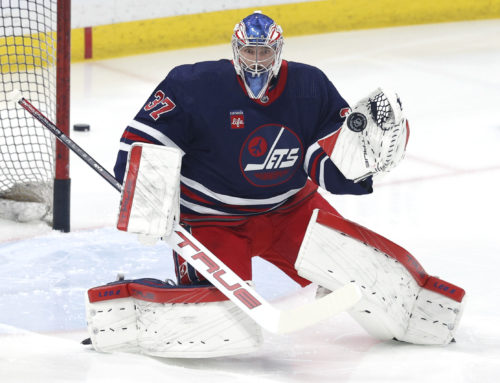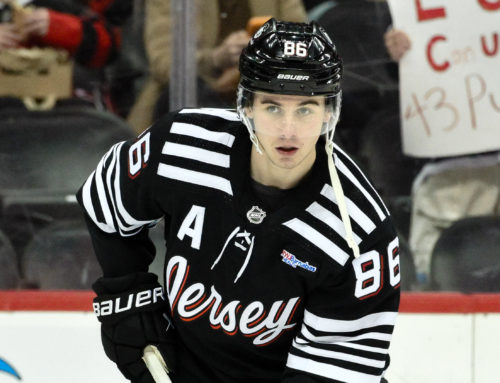Top 10 Players With Deflated Shot Percentage in 2021-22
Tom Collins
2022-06-06
Now that the postseason is almost over, it’s time to start thinking about next year’s fantasy leagues, especially for keeper leagues as trading re-opens in many pools.
One shrewd tactic is to focus on acquiring players who struggled this past season and who had a significantly lower than usual shooting percentage. A player taking 200 shots in a season that sees a drop of five percentage points would see a decrease in 10 goals. That’s a significant number and can turn a 65-point keeper into a 55-point borderline drop.
Of course, there are multiple reasons why a player may see a drop in shooting percentage. An injury could impact the velocity and accuracy of the shot. A new coach might have a different system that doesn’t benefit the player. An older player may get tired of going to the net and choose to shoot from the perimeter instead.
The key is to figure out which players might rebound. Below are 10 players who saw a shooting percentage decline this season that you should be thinking about for next season.
We want to look at players who generally take a lot of shots, as a player who went from 50 shots to 30 doesn’t mean much if his shooting percentage also drops five percentage points.
10. Travis Konecny
On the bright side for Konecny owners (and there weren’t many this year), Konecny averaged 2.8 shots per game, easily a career high. However, he only scored on 7.3 percent of his shots. He came into this season averaging a 12.8 shooting percentage, so that was a significant drop. If he had matched his career average, he would have finished with 28 goals instead of 16. Those extra 12 goals would have pushed him to a career-high 64 points and his season wouldn’t have seemed so poor.
Voracek led the Blue Jackets in points with 62, but finished with only six goals, tied for 16th on the team. That’s what happens when you shoot 4.1 percent. He has rarely had a high shooting percentage (only twice finishing above 10 percent shooting twice in his 14-year career), but he still averaged 9.2 percent with the Flyers. An average shooting season from him would have given him an extra eight goals.
It’s kind of funny that in Granlund’s two disappointing years in Nashville, he had a higher shooting percentage. In his bounce-back season this year, his shooting percentage dropped. In 2019-20, he scored on 13.1 percent of his shots. Last year, that number rose to 17.6 percent. However, in each of those two years, he put up an 82-game pace of 39 points and 43 points. This year, his shooting percentage dropped to 9.4 percent, but his 82-game pace was 66 points. He’s still not shooting as much as he did a few years back (only 1.5 shots per game, about one shot fewer per game), but he benefited from many other Nashville players seeing an increase in shooting percentages.
Many of the Flyers struggled this season, maybe none more than Couturier. He played in only 29 games because of injury, but those 29 games were a struggle. He scored only six goals and was on pace for 48 points over an 82-game season, which was his first non-70-point pace since 2016-17. His shooting percentage was 7.6 percent, a big drop from the 15 percent he had a year ago and his five-year average of 13.5 percent. He didn’t play enough games this year where the shooting percentage dip would have made a big difference in his final numbers, but it is something to keep in mind when drafting him next year.
RNH seems like he should have had a 30-goal season by now, but it has yet to happen in his 11-year career. He’s pretty consistent in shots per game (this year that number was 2.4), but his injury history derails his opportunity at a 30-goal campaign. This year, his shooting percentage fell to 7.1 percent, the fourth straight season his shooting percentage dropped. He’s gone from 16 percent in 2017-18 to 13.5 percent to 12.8 percent to 11.9 percent. You would think playing with Leon Draisaitl and Connor McDavid would make it easier to score goals and lead to a higher shooting percentage, but that hasn’t been the case for Nugent-Hopkins.
Last week, Radulov made my list of one of the 10 most disappointing players this past season. Some of that disappointment can be chalked up to a poor shooting percentage. He averaged 15.7 percent with Nashville, 12.2 percent in his one season with the Habs and 12.9 percent in his first four seasons with Dallas. So this year’s 4.3 percent was insanely low. It didn’t help that he averaged only 1.3 shots per game. Even with the low shots-per-game number, if he had continued his 12.2 percent shooting rate, he would have finished with 12 goals instead of four.
It’s always tough when your player has a decline in shots per game and shooting percentage, and Gallagher is a prime example from this season. Gallagher shot 4.9 percent, but we’ve seen this from him before. After averaging 10.2 percent from 2012-13 to 2015-16, he dropped to 5.3 percent in 2016-17 and scored a career-low 10 goals. He bounced back the next four seasons to an average shooting percentage of 11 percent. It’s during this time that he became a two-time 30-goal scorer and averaged 3.53 shots per game. This year, he was down to 2.5 shots a game. Even with the decline in shots, if he averaged 11 percent shooting, he’d have finished with 16 goals, more than double his final total of seven.
3. Phil Kessel
Just how bad was Kessel’s shooting season? Going into this year, his worst ever shooting percentage was 6.5 percent in his rookie season way back in 2006-07. Last year, it was a career-high 17.4 percent, and he came into the season averaging 11.1 percent for his career. However, this year, he shot a measly 4.6 percent. Ouch. That low number is made worse by the fact he only averaged 2.1 shots per game, tied with last season for the lowest of his career. While he’s a shoo-in to play in every game, he has stopped contributing in almost every category. However, you can’t expect next year to be as bad, especially if the soon-to-be unrestricted free agent winds up on a team with better offensive players.
Interestingly, the two players who suffered the highest shooting percentage drop made up for it with a career high in shots per game. In the four seasons preceding this one, Bergeron averaged a 14.3 percent shooting percentage. This year, that number dropped to 8.5 percent. That’s a significant drop, but it was offset by his career-high four shots per game. An average 14.3 shooting percentage would have left him with a career-high 42 goals, 17 more than the 25 he potted.
From 2016-17 to last season, Marchand averaged a shooting percentage of 17.2 percent, and he reached a career-high 20.3 percent a year ago. This year, that number dropped to 13.2 percent. It went unnoticed as he shot a career-high 3.5 shots per game, only the second time he’s broken three shots per game average. If he had shot his 17.2 percent average, he would have finished with 42 goals instead of 32. Another interesting tidbit about Marchand was that he shot 19.4 percent in his first 35 games. Then the Bruins broke up the top line to spread the offense around, and Marchand shot 8.2 percent in his last 35 games.





 BUF
BUF N.J
N.J PHI
PHI MIN
MIN VAN
VAN FLA
FLA TOR
TOR CGY
CGY S.J
S.J